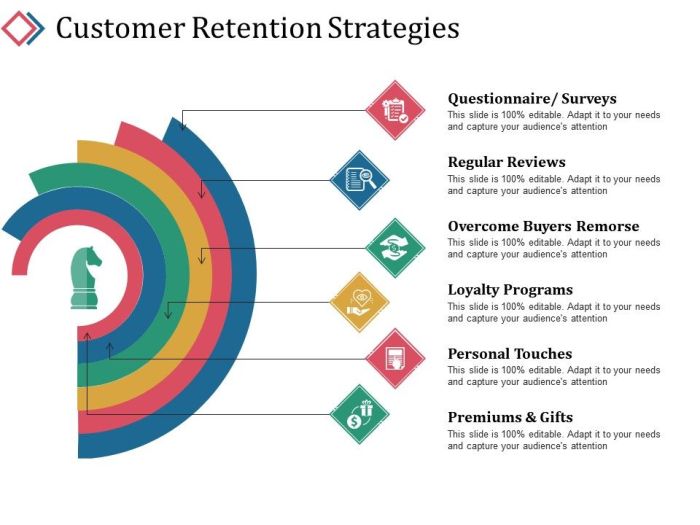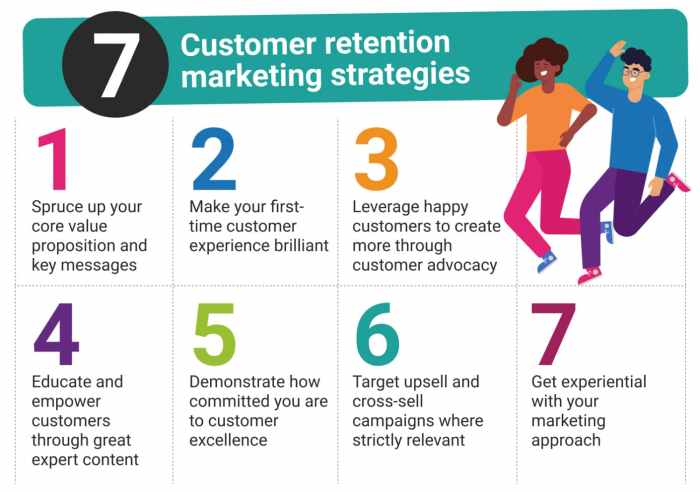Building a Customer Retention Plan jumps right into the action, offering readers a glimpse into the world of customer retention with a cool, high school hip vibe that guarantees an interesting read.
As we dive deeper, we’ll uncover the keys to creating a solid plan that keeps customers coming back for more.
Importance of Customer Retention Plans
Having a customer retention plan is crucial for businesses to ensure long-term success and sustainability in the competitive market.
By focusing on customer retention, businesses can benefit from repeat purchases, increased customer loyalty, positive word-of-mouth referrals, and reduced marketing costs compared to constantly acquiring new customers.
Benefits of Customer Retention
- Stronger Customer Relationships: Building trust and loyalty with existing customers can lead to increased customer satisfaction and retention.
- Higher Profitability: Loyal customers are more likely to make repeat purchases and spend more, resulting in increased revenue and profitability.
- Cost-Effective Marketing: Retaining customers is more cost-effective than acquiring new ones, as it involves less marketing spend and resources.
- Referral Business: Satisfied customers are more likely to refer friends and family to the business, leading to new customers through word-of-mouth marketing.
Understanding Customer Behavior
Analyzing customer behavior is crucial in designing an effective retention plan because it allows businesses to gain insights into what motivates customers to stay loyal. By understanding their preferences, habits, and purchasing patterns, companies can tailor their strategies to meet the specific needs of their customers.
Tools and Methods for Tracking Customer Preferences, Building a Customer Retention Plan
- Customer Relationship Management (CRM) software: CRM systems help businesses keep track of customer interactions, purchases, and feedback, providing valuable data for understanding preferences.
- Surveys and feedback forms: Gathering direct feedback from customers can offer insights into their satisfaction levels, preferences, and areas for improvement.
- Website analytics: Analyzing website traffic, click-through rates, and bounce rates can provide information on customer behavior and preferences.
- Social media monitoring: Monitoring social media platforms for mentions, comments, and reviews can help businesses understand how customers perceive their brand.
Role of Customer Segmentation in Personalized Retention Strategies
Customer segmentation involves categorizing customers into groups based on similar characteristics or behaviors. This segmentation allows businesses to create personalized retention strategies that target each group’s specific needs and preferences.
- Demographic segmentation: Dividing customers based on age, gender, income, etc., helps in tailoring marketing messages and offers to different demographic groups.
- Behavioral segmentation: Segmenting customers based on their buying behavior, such as frequent purchasers, occasional buyers, or first-time customers, allows for targeted retention efforts.
- Psychographic segmentation: Understanding customers’ lifestyles, values, and attitudes can help in creating personalized experiences that resonate with their preferences.
- Transactional segmentation: Grouping customers based on their purchase history, order frequency, and average spend enables businesses to offer relevant promotions and incentives to encourage repeat purchases.
Creating Personalized Customer Experiences

Offering personalized experiences is crucial for enhancing customer retention because it makes customers feel valued and understood. When customers receive tailored products or services that cater to their individual needs and preferences, they are more likely to develop a sense of loyalty towards the brand.
Strategies for Tailoring Products/Services
One strategy for tailoring products/services is to gather data about customer preferences and behavior through surveys, purchase history, and online interactions. This data can then be used to create personalized recommendations, discounts, or exclusive offers for each customer.
Another approach is to segment customers based on their demographics, purchasing habits, or psychographic characteristics. By categorizing customers into different groups, businesses can tailor their marketing messages and product offerings to better meet the specific needs of each segment.
Leveraging Technology for Personalized Experiences
Technology plays a crucial role in delivering personalized experiences at scale. Customer relationship management (CRM) software can help businesses track customer interactions, preferences, and feedback, allowing them to provide targeted communications and offers.
Artificial intelligence and machine learning algorithms can analyze large amounts of customer data to identify patterns and predict future behavior. This enables businesses to automate personalized recommendations, product suggestions, and marketing campaigns based on individual customer profiles.
Implementing Loyalty Programs: Building A Customer Retention Plan

Implementing loyalty programs is a crucial strategy for businesses looking to retain customers and foster long-term loyalty. By offering rewards and incentives to repeat customers, companies can create a strong bond that encourages continued patronage.
Benefits of Loyalty Programs
- Loyalty programs help increase customer retention rates by making customers feel valued and appreciated.
- They can also boost customer engagement and encourage repeat purchases, leading to higher overall revenue.
- By collecting data on customer behavior through loyalty programs, businesses can gain valuable insights that can be used to tailor marketing strategies and improve customer experiences.
Successful Loyalty Program Structures
- Starbucks Rewards: Starbucks offers a tiered loyalty program where customers earn stars for each purchase and unlock different rewards as they progress through the levels.
- Amazon Prime: Amazon’s subscription-based loyalty program offers members benefits such as free two-day shipping, exclusive deals, and access to streaming services.
- Sephora Beauty Insider: Sephora’s loyalty program rewards customers with points for every purchase, which can be redeemed for beauty products and exclusive experiences.
Measuring Loyalty Program Effectiveness
- Tracking customer engagement: Monitoring how frequently customers engage with the loyalty program can provide insights into its effectiveness.
- Net Promoter Score (NPS): Utilizing NPS surveys can help businesses gauge customer satisfaction and loyalty levels influenced by the loyalty program.
- Analyzing customer retention rates: Comparing retention rates of loyalty program members versus non-members can indicate the impact of the program on customer loyalty.